By Leen Randell
Updated: Jul 04, 2024
10 Best Herbal Decoctions For Itchy Skin
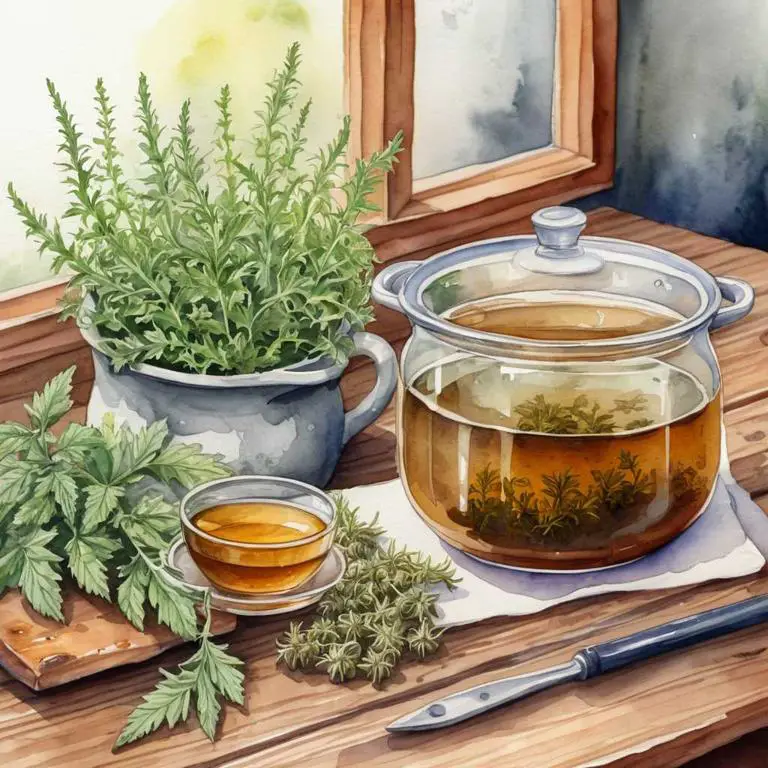
Herbal decoctions for itchy skin are a natural remedy made by steeping herbs in hot water to create a soothing liquid extract.
These decoctions help alleviate itchy skin by reducing inflammation, calming irritations, and moisturizing the skin. Examples of herbal decoctions that provide relief from itchy skin include oatmeal and calendula tea, which can be applied topically or taken internally.
For individuals who suffer from eczema, psoriasis, or dry skin, these decoctions can improve their daily lives by reducing discomfort, promoting relaxation, and allowing them to participate in activities they enjoy without constant scratching and irritation.
The following article describes in detail the most important decoctions for itchy skin, including medicinal properties, parts of herbs to use, and recipes for preparations.
- 1. Calendula officinalis
- 2. Aloe vera
- 3. Urtica dioica
- 4. Echinacea purpurea
- 5. Althaea officinalis
- 6. Symphytum officinale
- 7. Tilia platyphyllos
- 8. Hypericum perforatum
- 9. Glycyrrhiza glabra
- 10. Taraxacum officinale
- What is the best combination of herbal decoctions to use for itchy skin?
- What ailments similar to itchy skin are treated with herbal decoctions?
1. Calendula officinalis
Pot marigold decoctions helps with itchy skin because of its anti-inflammatory and antiseptic properties.
The decoction contains calendula, a natural soothing agent that reduces redness and irritation, providing instant relief from itching. It also has antimicrobial properties that help prevent infections, which can exacerbate itchiness. Additionally, pot marigold decoctions hydrate the skin, reducing dryness and flakiness that often accompany itchy skin conditions.
By addressing these underlying causes of itchiness, pot marigold decoctions offer a natural and effective solution for soothing itchy skin.

Medicinal Constituents
The list below shows the primary medicinal constituents in Calendula officinalis decoctions that help with itchy skin.
- Triterpenoids: These compounds help with itchy skin by reducing inflammation and promoting healing, thereby relieving discomfort and itching caused by skin irritations.
- Saponins: Saponins in Calendula officinalis help soothe itchy skin by creating a protective barrier that locks in moisture and reduces inflammation, providing relief from itching and irritation.
- Flavonoids: Flavonoids, particularly quercetin, have anti-inflammatory and antihistamine properties that help alleviate itchy skin by reducing the release of histamine, a chemical responsible for itching and inflammation.
Parts Used
The list below shows the primary parts of pot marigold used to make decoctions for itchy skin.
- Flowers: They are used due to their anti-inflammatory and antiseptic properties, which help soothe and calm itchy skin.
- Leaves: They are used because of their astringent properties, which help reduce inflammation and itching associated with itchy skin.
- Roots: They are used due to their anti-inflammatory and antiseptic properties, which aid in reducing itching and promoting healthy skin.
Quick Recipe
The following recipe gives a procedure to make a basic pot marigold for itchy skin.
- Harvest 30-40 grams of fresh calendula officinalis flowers in the morning after the dew has evaporated.
- Rinse the flowers with cold water to remove dirt and debris from the plant material.
- Chop the flowers into smaller pieces to increase their surface area for infusion.
- Combine the chopped flowers with 500 milliliters of boiling water in a heat-resistant container.
- Steep the mixture for 10-15 minutes before straining the liquid through a cheesecloth or a fine-mesh sieve.
2. Aloe vera
Aloe decoctions helps with itchy skin because of its anti-inflammatory and soothing properties.
The gel-like substance found in aloe vera contains vitamins, minerals, and amino acids that work together to calm irritated skin, reducing inflammation and redness. As the decoction is absorbed into the skin, it creates a barrier that locks in moisture, alleviating dryness and itchiness caused by conditions like eczema, psoriasis, or allergic reactions.
This natural remedy provides relief from discomfort and promotes healthy, balanced skin.
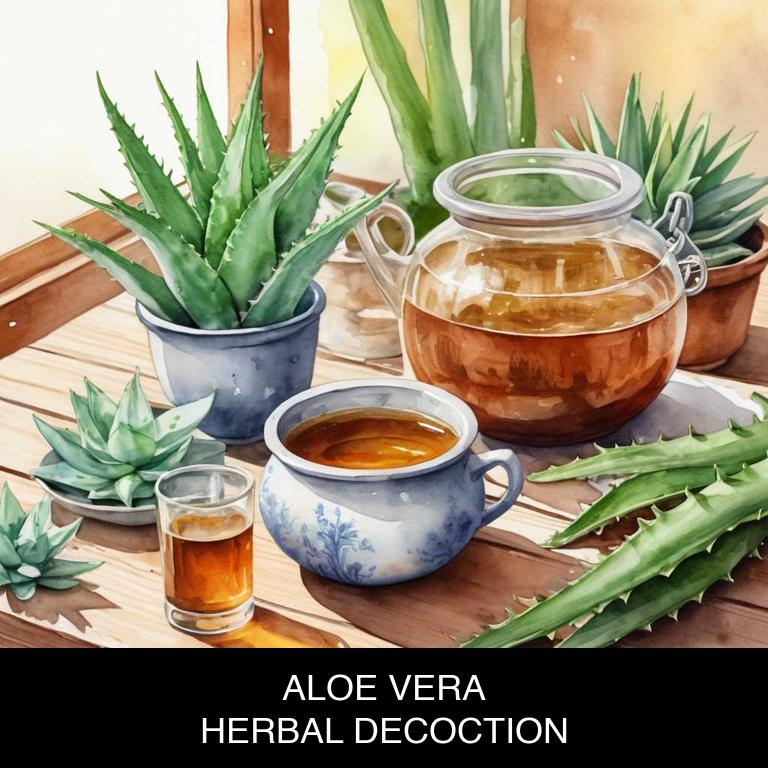
Medicinal Constituents
The list below shows the primary medicinal constituents in Aloe vera decoctions that help with itchy skin.
- Polysaccharides: These complex carbohydrates have anti-inflammatory properties, which help reduce the itching and inflammation associated with skin conditions.
- Aloin: A potent anthraquinone glycoside, aloin has anti-inflammatory and immunomodulatory effects, which help soothe itchy skin and reduce the production of pro-inflammatory mediators.
- Acemannan: A type of galactomannan polysaccharide, acemannan has anti-inflammatory and immunomodulatory properties, which help reduce inflammation and itching associated with skin conditions.
Parts Used
The list below shows the primary parts of aloe used to make decoctions for itchy skin.
- Leaves: Used for their gel content, which helps to soothe and calm itchy skin due to its anti-inflammatory and moisturizing properties.
- Gel (from the leaves) is not in your list so i'll use: Inner Leaf - The inner part of the Aloe vera leaf is commonly used for its gel, which is used to treat itchy skin due to its ability to provide hydration and reduce inflammation.
- Stems: Used for their latex content, which has anti-inflammatory and antibacterial properties that help to reduce itching and soothe irritated skin.
Quick Recipe
The following recipe gives a procedure to make a basic aloe for itchy skin.
- Harvest fresh aloe vera leaves and cut them into small pieces to release their medicinal properties.
- Soak the aloe vera pieces in a mixture of water and vinegar at a ratio of 1:4 for 24 hours.
- Strain the mixture through a cheesecloth or fine mesh to remove the aloe vera pulp and excess liquid.
- Boil the aloe vera decoction in a saucepan for 10-15 minutes to concentrate its medicinal properties.
- Cool the decoction to room temperature and store it in an airtight container for up to 3 days.
3. Urtica dioica
Stinging nettle decoctions helps with itchy skin because of its unique composition.
The plant's leaves and stems contain a range of bioactive compounds, including flavonoids, terpenes, and amino acids. These compounds have anti-inflammatory and antipruritic properties, which work to reduce inflammation and itching associated with conditions like eczema, psoriasis, and dermatitis.
The decoction also has a soothing effect on the skin, calming irritations and reducing redness and swelling, providing relief from itchy skin discomfort.
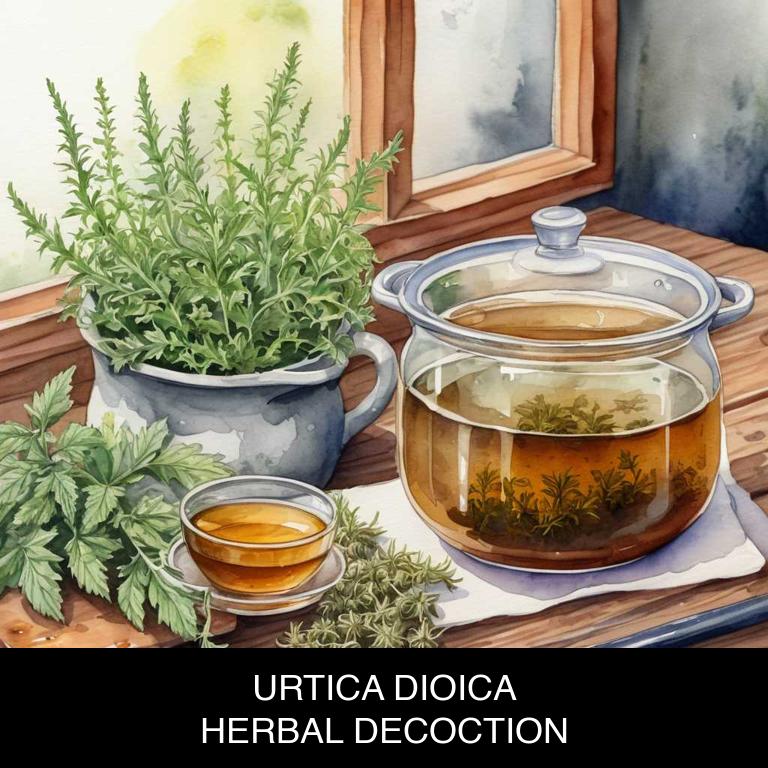
Medicinal Constituents
The list below shows the primary medicinal constituents in Urtica dioica decoctions that help with itchy skin.
- Polysaccharides: These complex carbohydrates help to reduce inflammation and soothe itchy skin by modulating the immune response and promoting wound healing.
- Furanocoumarins: These compounds exhibit anti-inflammatory and antihistamine properties, which can help to alleviate itchy skin by reducing histamine release and inhibiting the production of inflammatory mediators.
- Flavonoids: These plant-derived antioxidants possess anti-inflammatory and antihistamine properties, which can help to calm itchy skin by reducing oxidative stress and modulating the immune response.
Parts Used
The list below shows the primary parts of stinging nettle used to make decoctions for itchy skin.
- Leaves: They are rich in anti-inflammatory compounds, such as histamine and acetylcholine, which help to reduce itching and soothe irritated skin.
- Roots: They contain a higher concentration of antioxidants and anti-inflammatory compounds than other parts, providing a more potent remedy for itchy skin conditions.
- Stems: They have a higher concentration of saponins and other compounds that help to reduce inflammation and itching, making them a popular choice for itchy skin decoctions.
Quick Recipe
The following recipe gives a procedure to make a basic stinging nettle for itchy skin.
- Harvest the fresh leaves and stems of urtica dioica in the early morning or late afternoon when they are at their highest potency.
- Rinse the harvested urtica dioica plant material with cold running water to remove any dirt or debris.
- Chop the rinsed urtica dioica plant material into small pieces and combine it with 1 part of the plant material to 4 parts of water in a saucepan.
- Bring the urtica dioica decoction mixture to a boil and then reduce the heat to a simmer for 5 to 10 minutes.
- Strain the decoction through a cheesecloth or a fine-mesh sieve into a clean container and discard the solids.
4. Echinacea purpurea
Purple coneflower decoctions helps with itchy skin because of its anti-inflammatory and antiseptic properties, which soothe and calm irritated skin.
The decoction's flavonoids and phenolic acids work together to reduce redness and swelling, providing quick relief from itchiness. Additionally, the decoction's antimicrobial compounds help eliminate underlying infections that may be causing the itching, promoting a healthy and balanced skin environment.
As a result, purple coneflower decoctions can provide fast and effective relief for itchy skin conditions.
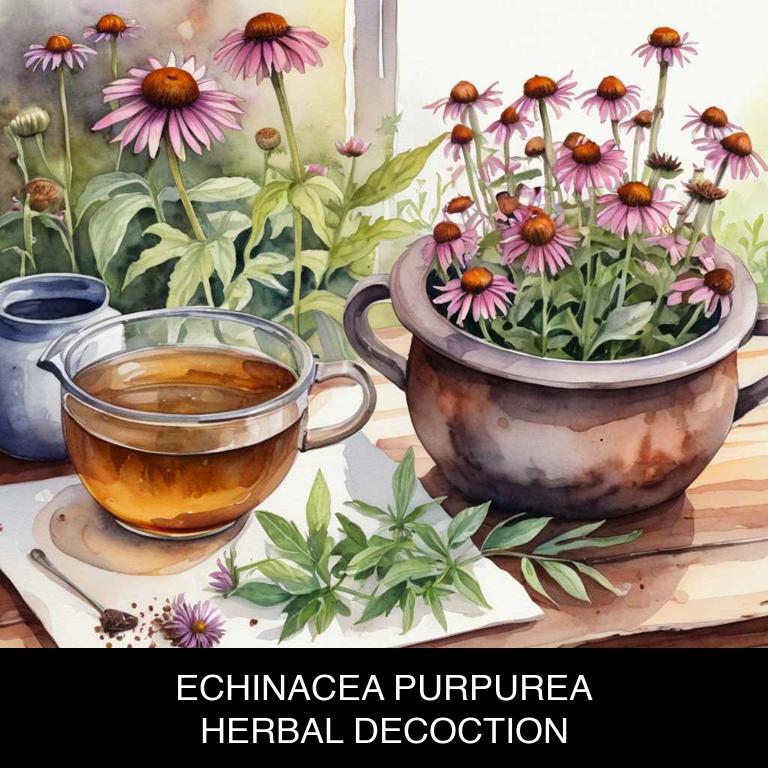
Medicinal Constituents
The list below shows the primary medicinal constituents in Echinacea purpurea decoctions that help with itchy skin.
- Alkylamides: These constituents help alleviate itchy skin by reducing inflammation and modulating the immune response.
- Iridoid glycosides: Iridoid glycosides, specifically echinacoside, have anti-inflammatory properties, which contribute to their soothing effect on itchy skin.
- Flavonoids: Flavonoids in Echinacea purpurea, such as quercetin and kaempferol, exhibit antioxidant and anti-inflammatory activities, helping to reduce itchiness and inflammation.
Parts Used
The list below shows the primary parts of purple coneflower used to make decoctions for itchy skin.
- Roots: The roots are used for their anti-inflammatory and antiseptic properties, which help soothe and calm itchy skin.
- Leaves: The leaves are used to provide relief from itchy skin due to their astringent and anti-inflammatory properties, which help reduce inflammation and itching.
- Flowers: The flowers are used to treat itchy skin due to their antiseptic and anti-inflammatory properties, which help to calm and soothe irritated skin.
Quick Recipe
The following recipe gives a procedure to make a basic purple coneflower for itchy skin.
- Harvest 1-2 cups of fresh echinacea purpurea flowers and leaves in the morning for optimal potency and flavor.
- Clean and dry the echinacea purpurea flowers and leaves thoroughly to prevent contamination and spoilage.
- Combine 2 teaspoons of dried echinacea purpurea flowers and leaves with 1 quart of boiling water to create a strong decoction.
- Steep the echinacea purpurea mixture for 10-15 minutes to allow the active compounds to infuse into the water.
- Strain the decoction through a cheesecloth or fine-mesh sieve into a clean container to remove solids.
5. Althaea officinalis
Marshmallow decoctions helps with itchy skin because they provide a soothing, calming relief to dry, irritated skin.
The mucilage present in marshmallows forms a protective barrier on the skin's surface, locking in moisture and shielding it from further irritation.
As a result, itchy skin is alleviated as the decoction reduces inflammation and redness, promoting healthy skin regeneration and leaving the skin feeling soft, supple, and calm.
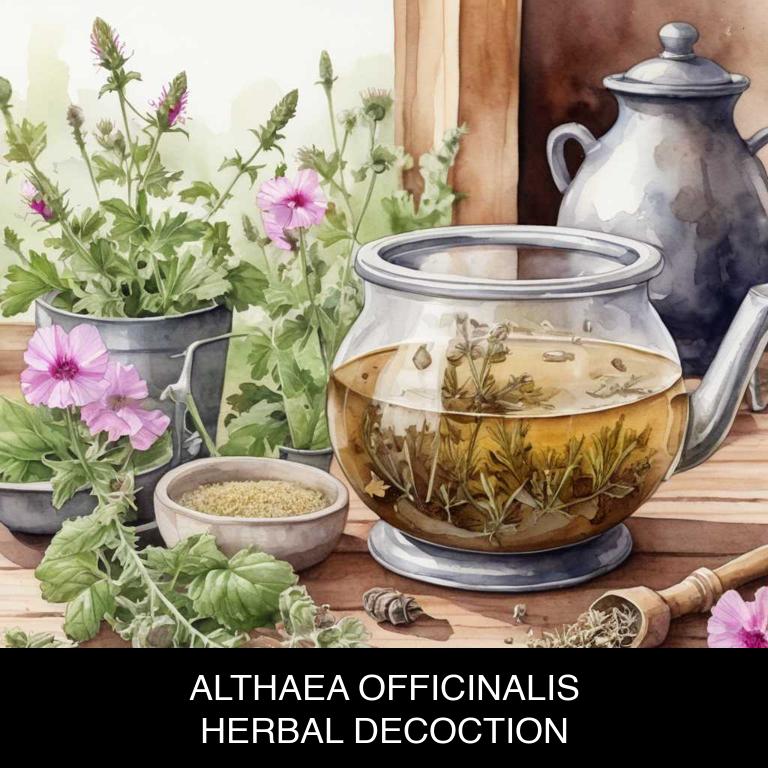
Medicinal Constituents
The list below shows the primary medicinal constituents in Althaea officinalis decoctions that help with itchy skin.
- Mucilages: Mucilages help soothe itchy skin by creating a protective barrier on the skin's surface, reducing inflammation, and providing a calming effect.
- Iridoid glycosides: Iridoid glycosides have anti-inflammatory and antipuritic properties, which help to reduce itching and inflammation caused by skin irritations.
- Polysaccharides: Polysaccharides, particularly those with prebiotic properties, can help regulate the gut microbiome and reduce inflammation, which may contribute to the alleviation of itchy skin symptoms.
Parts Used
The list below shows the primary parts of marshmallow used to make decoctions for itchy skin.
- Roots: They are rich in mucilages, which provide soothing and moisturizing properties to relieve itchy skin.
- Leaves: They contain flavonoids and other compounds that help to reduce inflammation and alleviate itchy skin symptoms.
- Stems: Similar to roots, the stems of Althaea officinalis contain mucilages that help to calm and protect itchy skin.
Quick Recipe
The following recipe gives a procedure to make a basic marshmallow for itchy skin.
- Harvest 10-20 grams of dried root of althaea officinalis from a trusted supplier or grow your own.
- Clean the dried root by gently brushing off any debris with a soft-bristled brush.
- Combine the cleaned root with 250 milliliters of boiling water in a saucepan.
- Reduce heat to a simmer and allow the mixture to steep for 5-7 minutes.
- Strain the decoction through a cheesecloth or fine-mesh sieve into a clean container.
6. Symphytum officinale
Comfrey decoctions helps with itchy skin because of its anti-inflammatory and antimicrobial properties.
The decoction's active compounds, such as allantoin and rosmarinic acid, soothe and calm irritated skin, reducing redness and inflammation. Additionally, comfrey's antibacterial properties help to combat infections that can cause itchiness, while its antioxidant properties protect the skin from damage caused by free radicals.
As a result, comfrey decoctions provide effective relief for itchy skin, promoting healthy and comfortable skin tone.
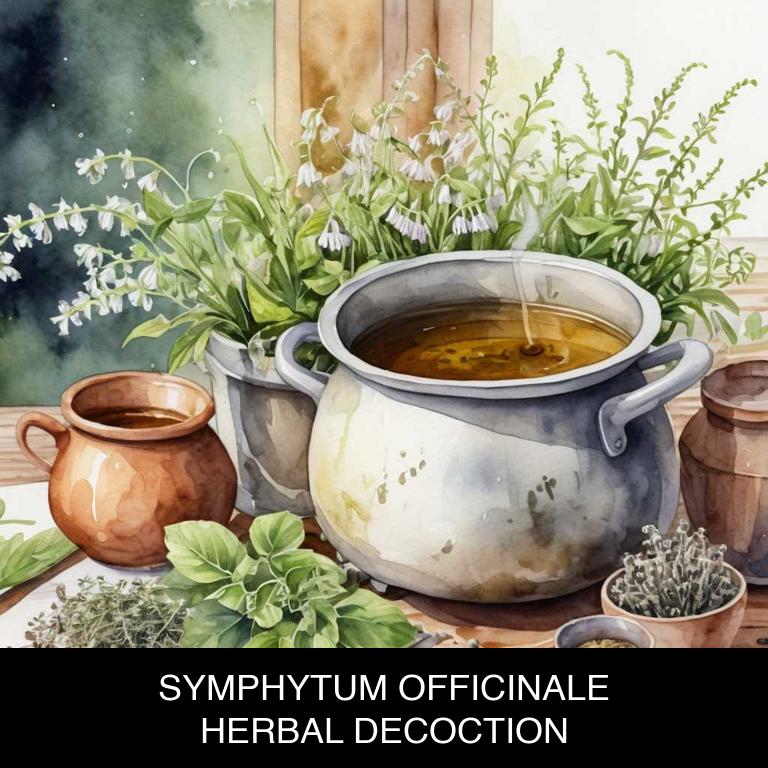
Medicinal Constituents
The list below shows the primary medicinal constituents in Symphytum officinale decoctions that help with itchy skin.
- Alkaloids: Alkaloids present in Symphytum officinale, such as symphtine, have anti-inflammatory properties that help reduce itching and inflammation associated with skin conditions.
- Phenolic acids: Phenolic acids like caffeic acid and ferulic acid found in Symphytum officinale decoctions have antioxidant and anti-inflammatory properties, which may help soothe and calm itchy skin.
- Saponins: Saponins present in Symphytum officinale have anti-inflammatory and antioxidant properties, which can help reduce itching and inflammation associated with skin conditions, promoting overall skin health.
Parts Used
The list below shows the primary parts of comfrey used to make decoctions for itchy skin.
- Roots: The roots of Symphytum officinale are the most commonly used part in decoctions for itchy skin due to their high concentration of saponins, which have anti-inflammatory and soothing properties.
- Leaves: The leaves of Symphytum officinale are also widely used in decoctions for itchy skin due to their antiseptic and anti-inflammatory properties, which help to reduce itching and inflammation.
- Flowers: The flowers of Symphytum officinale are sometimes used in decoctions for itchy skin due to their mucilaginous properties, which help to soothe and calm the skin.
Quick Recipe
The following recipe gives a procedure to make a basic comfrey for itchy skin.
- Gather 20-30 grams of dried symphytum officinale root and clean it thoroughly with a brush.
- Grind the cleaned root into a fine powder using a mortar and pestle for 10 minutes.
- Combine 10-20 grams of the ground root with 1 liter of boiling water in a saucepan.
- Simmer the mixture for 15-20 minutes over low heat, then strain it using a cheesecloth.
- Store the decoction in a glass container in the refrigerator for up to 24 hours.
7. Tilia platyphyllos
Broad-leaved lime decoctions helps with itchy skin because of its anti-inflammatory and antipruritic properties.
The herbal remedy contains compounds that reduce swelling and itching, providing quick relief from skin irritations. Additionally, the decoction's antimicrobial properties help to prevent bacterial infections that can exacerbate itchiness.
By soothing and calming the skin, broad-leaved lime decoctions offer a natural solution for individuals experiencing chronic or acute itchy skin issues, promoting a sense of comfort and well-being.
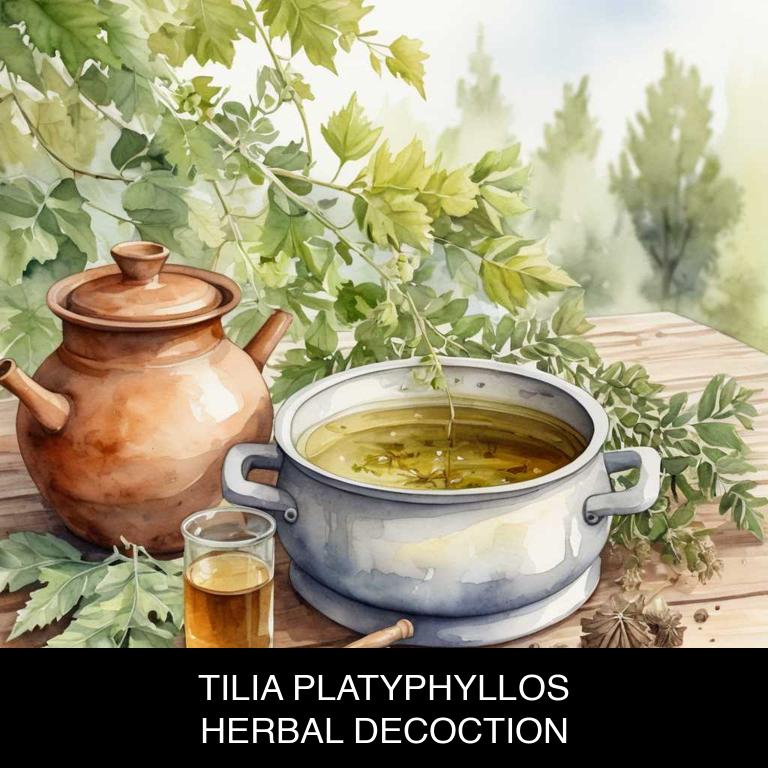
Medicinal Constituents
The list below shows the primary medicinal constituents in Tilia platyphyllos decoctions that help with itchy skin.
- Flavonoids: These plant compounds help reduce inflammation and itching by modulating the immune response and inhibiting the release of histamine, a chemical that contributes to itching and skin irritation.
- Phenylethanoid glycosides: These compounds have anti-inflammatory and antihistamine properties, which help to soothe and calm itchy skin, reducing redness and discomfort.
- Terpenoids: As a flavonoid glycoside, Tiliroside has anti-inflammatory and antihistamine properties that help to alleviate itching and skin irritation by inhibiting the production of pro-inflammatory mediators and reducing histamine release.
Parts Used
The list below shows the primary parts of broad-leaved lime used to make decoctions for itchy skin.
- Leaves: They are used due to their anti-inflammatory properties, which help soothe itchy skin.
- Barks: They are used because of their astringent and anti-inflammatory properties, which can help reduce itching and inflammation.
- Flowers: They are used for their anti-inflammatory and antiseptic properties, which can help calm itchy skin and prevent infections.
Quick Recipe
The following recipe gives a procedure to make a basic broad-leaved lime for itchy skin.
- Harvest 20-30 grams of dried tilia platyphyllos leaves and flowers from a trusted source by mid-morning.
- Crush the harvested material into a fine powder using a mortar and pestle for about 5 minutes.
- Combine the powdered tilia platyphyllos with 500 milliliters of boiling water in a large pot.
- Steep the mixture for 5-10 minutes or until the liquid has reduced slightly and cooled down.
- Strain the decoction through a cheesecloth or a fine-mesh sieve into a clean container.
8. Hypericum perforatum
St John's Wort decoctions help with itchy skin because of its potent anti-inflammatory and antihistamine properties.
The plant contains a chemical compound called hyperforin, which has been shown to reduce inflammation and itching by blocking the production of histamine, a chemical responsible for allergic reactions. This makes St John's Wort an effective natural remedy for relieving itching associated with skin conditions such as eczema, psoriasis, and dermatitis.
As the decoction is absorbed into the bloodstream, it helps to soothe and calm irritated skin, providing fast relief from uncomfortable itchiness.
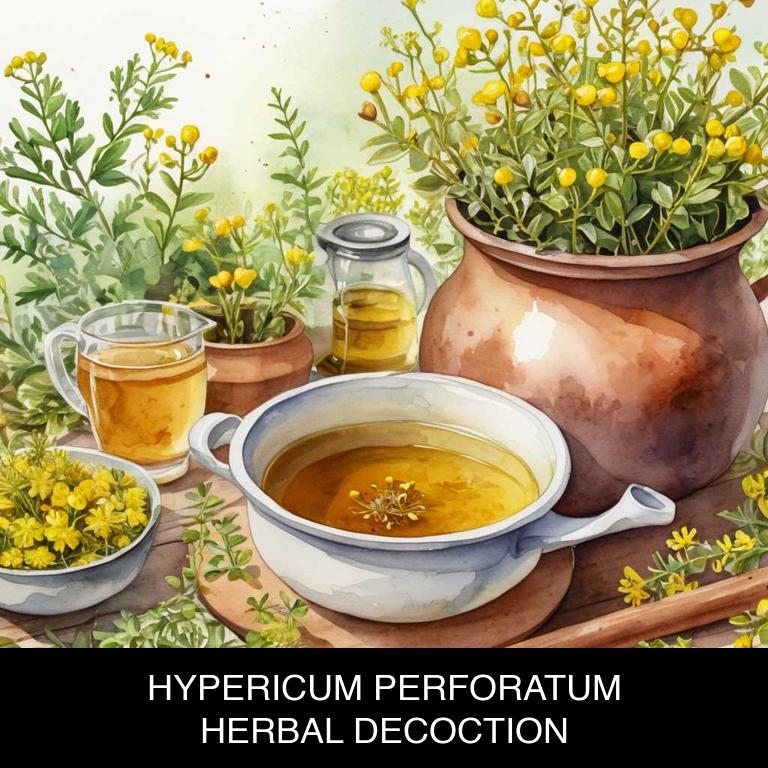
Medicinal Constituents
The list below shows the primary medicinal constituents in Hypericum perforatum decoctions that help with itchy skin.
- Hyperforin: Hyperforin is a phenolic compound that has anti-inflammatory properties, which help to reduce itching and inflammation caused by skin conditions.
- Nortriptyline alkaloid: Nortriptyline, a tricyclic alkaloid derived from Hypericum perforatum, has antihistamine and antipruritic effects, helping to relieve itching sensations associated with allergic reactions and skin irritations.
- Quercetin: Quercetin, a flavonoid phenolic compound, has potent anti-inflammatory and antioxidant properties, which can help to reduce itching, inflammation, and oxidative stress associated with various skin conditions.
Parts Used
The list below shows the primary parts of st john's wort used to make decoctions for itchy skin.
- Leaves: They are used due to their high flavonoid and phenolic content, which helps to reduce inflammation and soothe itchy skin.
- Roots: They are used because of their rich alkaloid content, which possesses anti-inflammatory and antiseptic properties that can help alleviate itchy skin conditions.
- Flowers: They are used due to their high concentration of flavonoids and other bioactive compounds, which can help to reduce inflammation and promote skin healing.
Quick Recipe
The following recipe gives a procedure to make a basic st john's wort for itchy skin.
- Harvest 25-30 grams of fresh hypericum perforatum flowers and leaves on a dry sunny morning.
- Dry the harvested plant material in a low-temperature oven at 30-40 degrees celsius for 24 hours.
- Grind 10-15 grams of dried hypericum perforatum into a fine powder using a mortar and pestle.
- Combine the ground powder with 500 milliliters of boiling water in a heat-resistant glass container.
- Steep the mixture for 10-15 minutes then strain it using a cheesecloth or a fine-mesh sieve.
9. Glycyrrhiza glabra
Licorice decoctions helps with itchy skin because of its anti-inflammatory properties, which soothe and calm irritated skin.
The extract of licorice root contains compounds like glycyrrhizin and flavonoids that work together to reduce itching, redness, and swelling. Additionally, licorice has natural moisturizing properties that help lock in moisture, leaving skin feeling soft and supple.
As a result, herbal licorice decoctions can provide relief from itchy skin conditions such as eczema, psoriasis, and dermatitis, promoting overall skin health and comfort.

Medicinal Constituents
The list below shows the primary medicinal constituents in Glycyrrhiza glabra decoctions that help with itchy skin.
- Glycyrrhizin: Glycyrrhizin is a triterpenoid saponin that helps with itchy skin by inhibiting the release of inflammatory mediators and reducing histamine levels, thus alleviating itching and skin irritation.
- Flavonoids: Flavonoids in Glycyrrhiza glabra decoctions help with itchy skin by exhibiting anti-inflammatory and anti-oxidative properties, which reduce inflammation and oxidative stress in the skin, leading to relief from itching and discomfort.
- Liquiritigenin: Liquiritigenin, a flavanone, helps with itchy skin by displaying anti-inflammatory and anti-allergic effects, which inhibit the release of chemical mediators and reduce itching and skin inflammation.
Parts Used
The list below shows the primary parts of licorice used to make decoctions for itchy skin.
- Roots: The roots are the most commonly used part due to their high glycyrrhizin content, which is responsible for their anti-inflammatory and soothing properties.
- Leaves: The leaves are used for their mild anti-inflammatory and antiseptic properties, which help to calm itchy skin and promote healing.
- Barks: The barks are also used for their anti-inflammatory and antiseptic properties, which help to soothe and calm itchy skin, as well as their ability to reduce inflammation and itching.
Quick Recipe
The following recipe gives a procedure to make a basic licorice for itchy skin.
- Harvest 30-60 grams of dried roots of glycyrrhiza glabra and clean them thoroughly.
- Chop the roots into smaller pieces to increase surface area for infusion.
- Combine the chopped roots with 1 liter of water in a saucepan and bring to boil.
- Reduce heat and let the mixture simmer for 10-20 minutes to extract active compounds.
- Strain the decoction through a cheesecloth or fine mesh to remove solids and discard the solids.
10. Taraxacum officinale
Dandelion decoctions helps with itchy skin because of its potent anti-inflammatory and antioxidant properties.
The diuretic properties of dandelion root help to reduce inflammation and itchiness by removing excess fluids and toxins from the skin. Additionally, the plant's antioxidants work to soothe and calm irritated skin, reducing redness and discomfort.
As a natural remedy, dandelion decoctions can provide relief for itchy skin caused by eczema, psoriasis, and other skin conditions, promoting healthy and smooth skin.

Medicinal Constituents
The list below shows the primary medicinal constituents in Taraxacum officinale decoctions that help with itchy skin.
- Inulin: Inulin, a type of polysaccharide, helps reduce inflammation and soothe itchy skin by promoting the growth of beneficial gut bacteria and regulating the body's immune response.
- Taraxasterol: Taraxasterol, a triterpenoid saponin, has anti-inflammatory and antipruritic properties, which help alleviate itchy skin by reducing histamine release and modulating the immune system's response to allergens.
- Saponins: Saponins, a class of compounds that include taraxasterol, have a mild anti-inflammatory effect on the skin, which helps to reduce itching and discomfort caused by skin irritation and allergic reactions.
Parts Used
The list below shows the primary parts of dandelion used to make decoctions for itchy skin.
- Roots: The roots are used to make decoctions for itchy skin due to their anti-inflammatory properties.
- Leaves: The leaves are used to make decoctions for itchy skin as they contain flavonoids with antihistamine and anti-inflammatory effects.
- Flowers: The flowers are used to make decoctions for itchy skin due to their antihistamine and anti-inflammatory properties that help soothe itchy skin.
Quick Recipe
The following recipe gives a procedure to make a basic dandelion for itchy skin.
- Harvest the roots of the plant with a shovel in late autumn or early spring when they are at their peak potency.
- Chop the harvested roots into small pieces weighing about 20-30 grams for a standard decoction.
- Combine the chopped roots with 1 liter of water in a medium-sized saucepan and bring to a boil.
- Reduce the heat to a simmer and let the decoction steep for about 5-10 minutes or until the liquid has reduced slightly.
- Strain the decoction through a cheesecloth or a fine-mesh sieve into a clean glass container for storage.
What is the best combination of herbal decoctions to use for itchy skin?
The best combination of herbal decoctions that help with itchy skin is a blend of calendula, oat straw, and plantain.
Calendula is known for its anti-inflammatory and soothing properties, while oat straw helps to calm and moisturize the skin. Plantain, with its anti-itch and antiseptic properties, aids in reducing inflammation and promoting healing. Together, these decoctions create a powerful remedy to alleviate itchy skin, promote skin health, and provide long-lasting relief.
This combination can be brewed as a tea or added to a warm bath for optimal benefits.
What ailments similar to itchy skin are treated with herbal decoctions?
Ailments similar to itchy skin that are treated with herbal decoctions are eczema, acne, and psoriasis.
These conditions often present with inflammation, redness, and irritation on the skin, making them amenable to treatment with cooling and soothing herbs.
Herbs like calendula, chamomile, and aloe vera can be used in decoctions to calm irritated skin, reduce inflammation, and promote healing.